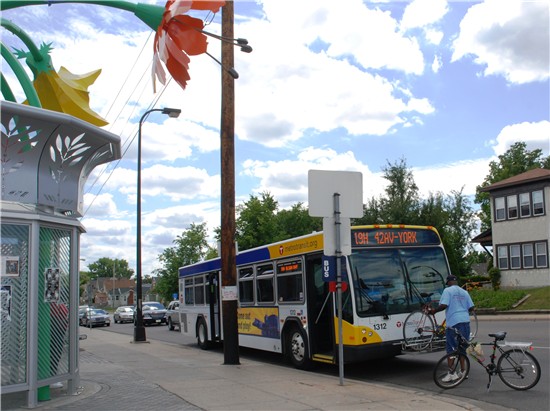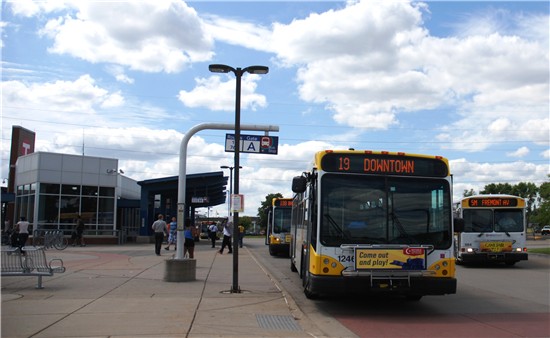
When Karen Bradford was young, she used to ride the bus to downtown Minneapolis with her grandmother so they could shop at the department stores lining Nicollet Mall.
Though she’s grown older, Bradford still uses the bus as her primary connection to downtown, where she shops, goes to doctor appointments or simply enjoys the city.
And she isn’t alone. On a recent afternoon, Bradford was among several customers traveling northbound on Route 19, which runs from Minneapolis to Brooklyn Center. The bus travels along Olson Memorial Highway, Penn Avenue and Osseo Road en route to the Brooklyn Center Transit Center, one of Metro Transit’s busiest boarding areas.
Last year, more than 2 million people boarded Route 19 buses, a more than 8 percent increase from 2011.
Like Bradford, many Route 19 customers say they do not own vehicles and that the bus serves as their primary mode of travel to work, school or shopping.
“This is my everyday transportation,” said Nick Lofton, 21, who lives in north Minneapolis and uses the bus to visit friends, shop and get to work. This fall, he plans to use the bus to get to and from classes at the Minneapolis Community & Technical College.
Keith and Jayme Talley use Route 19 every day, multiple times a day to fetch groceries, get to appointments and visit parks, including Theodore Wirth Park. “If we have a lot of stuff to do, we’ll be on the bus the majority of the day,” Jayme Talley said.
Because of the high, all-day demand Route 19 is part of Metro Transit’s Hi Frequency Network, with buses running every 15 minutes between downtown Minneapolis and the intersection of Penn and Lowry avenues. Midday and evening service was recently improved and morning and afternoon trips have been added to better serve customers, including Patrick Henry High School students now traveling to school with Go-To Student Passes.
Future improvements could come in the form of Arterial Bus Rapid Transit, which would move buses more quickly through the corridor by making fewer stops and using new technology like pre-paid fare payment, traffic signal priority and low-floor buses with front and rear entrances. Station areas would also be more fully developed.
Penn Avenue has been identified as the third potential Arterial Bus Rapid Transit corridor, after Snelling Avenue and West Seventh Street in St. Paul.
 Katie Roth, a project manager in Metro Transit's BRT/Small Starts Project Office, said BRT planning is just beginning but that plans could be put in motion as early as 2017. Route 19 and its branches would continue to provide local service even with the addition of BRT.
Katie Roth, a project manager in Metro Transit's BRT/Small Starts Project Office, said BRT planning is just beginning but that plans could be put in motion as early as 2017. Route 19 and its branches would continue to provide local service even with the addition of BRT.
Roth said the corridor stands out for improved service because it has strong all-day ridership and is an important connection to suburban routes in the northwest metro. Estimates suggest BRT service on Penn Avenue could draw up to 9,300 weekday riders by 2030.
BRT would come as just the latest evolution for transit on the Route 19 corridor.
Streetcars ran on Sixth Avenue North until 1940, when the road was rebuilt as Olson Memorial Highway. Portions of Penn Avenue also had streetcars until 1953. Until 2007, two routes served Penn Avenue — Route 19, which ran between Olson Memorial Highway and Golden Valley Road, and Route 5, which ran north of North 26th Avenue. Continuous service on Penn Avenue was implemented as part of a service restructuring in the northwest metro.
As Metro Transit prepares for the next evolution, it is participating in Hennepin County's Penn Avenue Community Works project, designed to enhance the corridor through a series of community-building projects. The Community Works project is focused on the area between Interstate 394 and the intersection of Osseo Road and 49th Avenue North.
One community-focused investment already in place is 'Blossoms of Hope,' a bus shelter that also serves as a striking piece of public art. Designed by landscape artist Marjorie Pitz and located at Broadway and Penn avenues, large metal flowers sprout from the top of the bus shelter adding color and life to the busy intersection (the shelter itself is meant to mimic a vase, Pitz said).
The flowers were installed shortly before the 2011 tornado struck Minneapolis, damaging several surrounding properties. After surviving relatively unscathed, the flowers became a "beacon of hope" and have persisted as a welcoming and encouraging landmark ever since, Pitz said.
"I wanted to make it (the shelter) into an attraction that would actually lift peoples' spirits when they came to wait for the bus," she said. "It's very joyful, colorful and happy."
 Route 19 At a Glance
Route 19 At a Glance
Type: Urban Local
Service: Route 19 runs between downtown Minneapolis and Bass Lake Road in Brooklyn Center, largely along Olson Memorial Highway, Penn Avenue and Osseo Road. As part of Metro Transit’s Hi Frequency network, buses run every 15 minutes between downtown Minneapolis and the Lowry Avenue-Penn Avenue intersection between 6 a.m. and 7 p.m. weekdays.
Route length: 8 miles
Stops: 79 northbound stops and 82 southbound stops
Vehicles: 40-foot standard buses
Ridership: Customers rode Route 19 more than 2 million times in 2012 — making it the tenth most-popular bus route. Average weekday ridership exceeds 6,400.
History: Buses began running on Penn Avenue after streetcars were taken out of service in 1953. Until Express Route 758 was introduced a decade ago, Route 19 buses ran west to Golden Valley. Penn Avenue was covered by two separate routes until 2007, when Route 19 was continued north to the Brooklyn Center Transit Center.
Future: Metro Transit has identified Penn Avenue as strong corridor for Arterial Bus Rapid Transit service. Preliminary planning is ongoing and implementation could come as early as 2017. BRT would improve travel times through the use of pre-paid fares and low-floor, front- and rear-entrance buses. Enhanced stations would also be built.